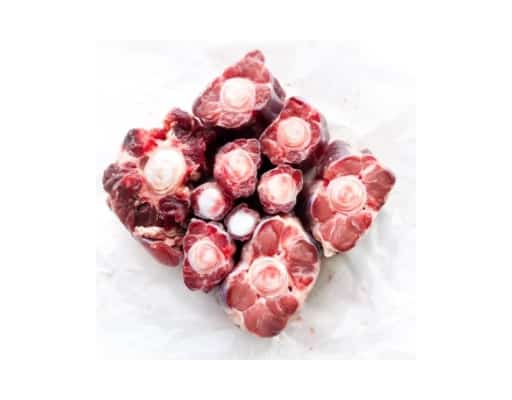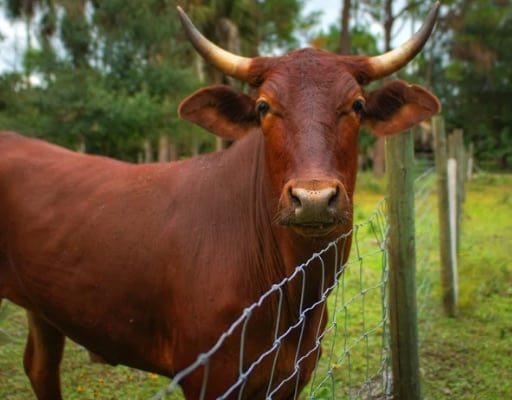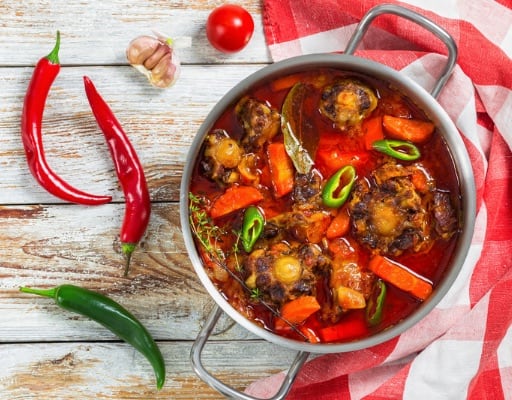When savoring the rich flavors of a steaming oxtail soup, have you ever paused to wonder where; what animal and exactly what part of the animal the meat actually comes from?
In this article today, we’ll embark on a quest to answer all these questions (plus more).
Stay tuned and keep reading!

What Animal Does Oxtail Come From?
Oxtail, as the name suggests, is derived from the tail of an “ox”, “bullock” or “steer” depending on which part of the world you come from, which is simply a castrated male cattle that has reached maturity.
In case you’re wondering what castration is, it’s a term used to refer to a process of deactivating the testes of male animals in order to prevent the production of hormones which would otherwise cause them to be aggressive.

This way, they are safe and easy to work with for a variety of purposes such as plowing or even riding.
In the modern culinary realm, the term “oxtail” has now come to refer to the tails of both male cattle (whether castrated or not) and female cattle.
The Structure And Nutrition Of Oxtail
When you take a close look at Oxtail, you’ll discover that the meat is made up of a beautiful network of meat, fat, bone and connective tissue which makes it unique.
The tail is segmented into vertebrae, each encased in a tussle of meat and fat and interspersed with connective tissues and tendons (to attach the meat to the bone that it surrounds).
The connective tissues are high in collagen, and when cooked produce gelatin give that unctuous and gummy mouthfeel after every bite of the meat.
When it comes to nutrition also, oxtail packs a punch with all sorts from protein, vitamins to minerals such as iron, cobalamin and phosphorus.
What Does Oxtail Taste Like?
The taste of oxtail is akin to other slow-cooked, tough cuts of beef like chuck and shank, but it possesses an even deeper, more intense meaty flavor due to the fact that it contains connective tissues, bone as well as the marrow.
As the oxtail cooks for an extended period in a slow cooker, the collagen in the connective tissues breaks down into gelatin which gives that melt-in-your-mouth tenderness when you bite into the meat and also cause thickening of the sauce that clings to the meat as you pull it out from the rest of the soup.
Like with any other cut of meat also, the taste of oxtail can vary slightly depending on the seasoning used for it as well as the techniques of preparation.
How Is Oxtail Cooked?
Oxtail is typically cooked using slow and moist-heat cooking techniques which allow the tough connective tissues and other parts of the meat to really get a chance to break down and yield a tender, melt-in-your-mouth texture.
Some of the most common cooking techniques used for oxtail include braising and stewing.

Here’s a brief overview of these methods:
Braising
Braising is one of the most preferred methods for cooking oxtail because it renders a really soft end result after cooking.
In the braising technique, oxtail pieces are first washed and seasoned well using salt and pepper, then seared on both sides in a hot pan (with hot oil in it) to develop a caramelized crust from Millard reaction which helps to enhance flavor and also seal any moisture that later builds up inside the meat.
After that, the meat is combined with a small amount of broth along with aromatics like herbs and flavor building ingredients and then cooked on low heat for about 3 to 4 hours.
Stewing
Stewing is similar to braising, just that in this case, a higher proportion of liquid is used to create the stew.
In this method, the oxtail is often browned first to intensify the flavor and lock in mosture (although it is not necessary), then simmered in a flavorful liquid such as stock or tomato-based sauce with vegetables and seasonings.
The dish is then cooked slowly on low heat either on the stove top or inside the oven, allowing the flavors to come together and the collagen to break down and yield a really tender and flavorful stew.
Slow-cooking
This is more of a mode of cooking than a recipe. Instead of using an oven or stovetop for the cooking, you can simply rely on your crock pot to do the magic for you.
Using this method, the beef can be seasoned and seared as with the braising or stewing technique, then it is placed in the crockpot and a flavorful broth (sometimes water) is added alongside seasonings and vegetables and then allowed to cook on low for about 8 to 10 hours.
Alternatively, the oxtail can be cooked effortlessly in an Instant Pot which offers a speedy and convenient method for preparation.
When it comes to the instant pot, the oxtail is cooked under high pressure which causes the meat to become tender in a short duration of time.
Typically, oxtail is cooked in an Instant Pot by first seasoning and sauteeing the meat using the ‘Sauté’ mode of the instant pot. Alternatively, the meat can be quickly sautéed on the stove top.
Then, the meat is stuffed in a broth enriched with herbs like thyme and bay leaves as well as sautéed vegetables like onions, garlic and radish.
The cooking is usually done at high pressure for approximately 45 minutes to 1 hour depending on the size of the pieces you have.
Why Is Oxtail So Expensive?
For anyone who purchases oxtail a lot, you’ll notice that the pieces aren’t exactly the cheapest to obtain (with a pound commanding about 10 bucks or so).
But why is that so? Why does the least favourite part of a cow, arguably, command a very high price per pound?
As it turns out, it’s because of a variety of factors related to demand, supply and processing.
Demand And Supply
Oxtail was never, in history, as popular as it is currently, all thanks to the dedicated focus of meat eaters on other parts of the cow.
With its sudden rise in popularity however, oxtail has become a sought-after ingredient in many traditional and contemporary recipes, increasing its demand and subsequently its overall cost due to a shortage of supply.
Remember that there is only a limited amount of oxtail available per animal, as it constitutes a very small portion of the overall carcass.
With just one tail per cow, the supply of oxtail is considerably lower than other cuts of the meat.
This limited availability, coupled with the rising demand certainly leads to an overall increase in price per pound of oxtail.
Processing
In addition to the factors of demand and supply, the processing of oxtail isn’t exactly smooth sailing.
Oxtail requires a labor-intensive processing compared to some meaty parts of the cow.
The tail must be carefully segmented into individual pieces, and sometimes the excess fat and connective tissue need to be trimmed off as well.
This additional processing and handling contribute to the overall cost of oxtail.
Culinary trends
Chefs and home cooks alike continue to experiment with and popularize oxtail dishes, which continue to make the once-underappreciated cut of meat gain more and more reputation as a gourmet ingredient.
This newfound status had helped elevate the price of oxtail, reflecting its culinary desirability.
Frequently Asked Questions
Does Oxtail Come From an Ox?
Yes, oxtail originally comes from an ox which is a castrated adult male cattle. However, in current culinary practices, the term “oxtail” is now an umbrella term that refers to the tails of both male and female cattle; the male may be castrated or not.
Does Oxtail Come From Kangaroo?
No, oxtail does not come from kangaroos and neither can the meat coming from the tail of kangaroo be classified as oxtail.
Kangaroo tail, which is also used in some traditional Australian recipes, is a separate cut of meat with a somewhat similar structure to oxtail but is slightly gamey when it comes to taste.
Where Does Jamaican Oxtail Come From?
Jamaican oxtail is simply making reference to a specific style of preparation of oxtail unique to Jamaican cuisine. It does not signify a separate type of “Jamaican” ox or animal from which the meat is derived from.
Jamaican oxtail typically involves slow-cooking or braising of the tail in a flavorful and aromatic sauce having a blend of spices and seasonings in it. The seasonings and spices could be: allspice, soy sauce, thyme, scotch bonnet peppers and browning sauce.

